The content on this website is for informational purposes only and is not meant to replace professional or medical advice. See our full disclaimer.
Task initiation is, simply put, getting started on something. If you or your child has ADHD, you probably know that certain tasks seem incredibly overwhelming. Sometimes you just can't start tasks.
This could apply to a straightforward task like changing clothes or showering. Or a more difficult task like starting a research paper or finishing homework.
To those with ADHD, it can feel like there's a brick wall between us and the task at hand. It seems impossible to climb that wall, and we'll do almost anything to avoid trying. This can lead to waiting until the last minute, task avoidance, and letting people down.
Well, today we're talking all about Task Initiation and ADHD, and (more importantly) 8 proven steps to help.
Let's dive into the solutions so you can finally start those tasks you don't want to do.
Jump to:
1. Break it down into the smallest possible task
In ADHD land, all tasks, easy or complex, can feel like a looming mountain. So what's the trick? Break tasks down into the smallest possible steps.
Imagine brushing your teeth broken down into mini-tasks:
- take out toothbrush
- squeeze toothpaste on the brush
- turn water on
- wet the toothbrush
- start brushing
This might seem like we're oversimplifying, but with a child with ADHD, it can work wonders.
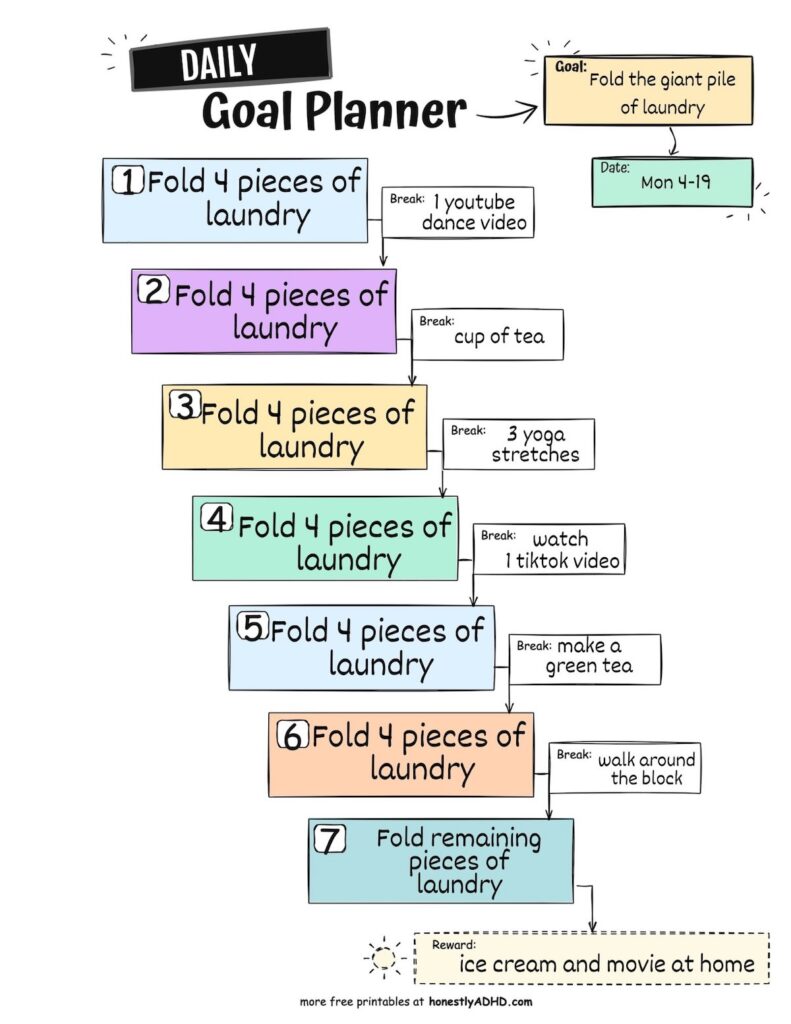
Try our free Goal-Setting Worksheet to help break down tasks.
Transforming a seemingly overwhelming task into manageable, bite-sized pieces can reduce anxiety and make task initiation easier.
When it's bedtime for my 6-year-old son, I guide him through each step, making sure he's engaged (remember, kids with ADHD can have an executive age 30% behind neurotypical children).
For example, to get him into his pajamas, I'll say:
- "Take off your shirt, put it in the hamper, and give me a high-five."
- After he does that, I'll say, "Great job! Now take off your pants, put them in the hamper, and give me a double high-five."
Eventually, he'll have his p.js on without any moaning and groaning. This step-by-step approach works much better than a blanket command like "Change into your pajamas."
For Adults
This task breakdown works for adults, too. You can break down big projects into smaller parts.
For example, here are some manageable steps for a research paper:
- Turn on your computer
- Research the topic thoroughly.
- Go to your favorite search engine.
- Type in your topic.
- Read through a few articles.
- Take notes on the most important points.
- Create an outline for the paper.
- Decide on the main points you want to cover.
- Note down the order in which you want to present them.
- Plan for a brief introduction and conclusion.
You get the idea! Our free daily planner sheets and our printable ADHD to-do lists help create achievable goals using this method. It encourages realistic time management and won't let you put too many tasks on your plate.
Another point to note is, it's best not to do too large of tasks all in one day. For instance, instead of cleaning out the entire fridge (which would take hours), it's best to tackle one shelf at a time. Split it up between several days!
This is much less intimidating and easier to start. (Not to mention, this prevents us from getting overwhelmed halfway through and not finishing).
We always recommend a small reward or treat when you've completed your task(s). That brings us to number two.
2. Rewards
Rewards, big or small, can be the key to getting both kids and adults with ADHD to start a task.
For my son, something as simple as a high-five works wonders (as noted above). More complicated tasks can be rewarded with some screen time or a treat. The thought of the reward can be a powerful push to get started.
As for adults, a reward could be your favorite latte waiting for you after you complete a report or a piece of chocolate after doing the laundry.
The proper reward will give you that hit of dopamine that makes the idea of starting a task all the more worth it. Keep a picture of the prize in your mind as you work on the task. That latte will taste so much better after a job well done!
3. Task Pairing
A great hack for task initiation is task pairing. This is when you combine a less pleasant task with something you enjoy.
Let's say you're an adult who detests washing dishes. Let's pair it up! How about watching your favorite Netflix show as you wash the dishes?
Suddenly, the dishes don't seem so bad while I'm watching an episode of The Great British Bakeoff. It's a win-win.
For kids, it works just as well. If the bedtime routine feels like a chore, make it enjoyable for them.
Turn on their favorite music as they brush their teeth, change into their pajamas, and prepare their backpack. Upbeat music for ADHD can make the boring routine more lively and engaging.
Task pairing can make the mundane seem less overwhelming, and in some cases, even fun!
4. Set a Timer
Sometimes, rewards and task pairing might not cut it. This is especially true for tasks that require your undivided attention. We don't want to distract our ADHD brain from something important.
For example, replying to emails or doing homework may not pair well with a TV show in the background. In these cases, timers can be your best friend.
Here's how you do it: set a timer for a small, achievable chunk of time, like 15 minutes. This short commitment feels less intimidating and can kickstart the task.
Work for a short time, then take a small break. The thought of a mini break right around the corner can make the task at hand feel less daunting. Rinse and repeat.
This strategy is often called the Pomodoro Technique. It's a simple (but highly effective) method of breaking work down into manageable chunks with regular breaks in between.1Pomodoro Technique It works wonders for ADHD and task initiation.
Here's how it works:
- Choose a Task: Select the specific task you want to work on. This could be anything from answering emails, studying for an exam, or writing a report.
- Set a Timer for 25 Minutes: The traditional length of a 'Pomodoro' is 25 minutes, but you can adjust this to fit your needs. The aim is to focus solely on your task for this period without any distractions or multitasking.
- Work on the Task: Immerse yourself in the task for the duration of the Pomodoro. If you have an unrelated idea or remember something you need to do, write it down to deal with later.
- Take a Short Break: Once the timer rings, stop working and take a short break of about 5-10 minutes. This let your brain rest and recharge.
- Repeat: After your break, set the timer again and dive back into your task (or a new task). After completing four Pomodoros, take a longer break of about 15 to 30 minutes.
The Pomodoro Technique is effective for several reasons. The time limit can create a sense of urgency, which can help you to start tasks and stay focused.
Breaks also help prevent burnout and maintain high energy levels for extended periods.
Be sure to fully disengage from your work during your break - stand up, move around, do some light stretching, or meditate. This helps ensure you're ready to dive back in fully refreshed for your next timed session.
5. Create a Ritual
A ritual for ADHD is like a hybrid of task pairing, rewards, and task breakdown.
We're not talking about the ceremonial stuff tied to religion or culture. A ritual for ADHD is all about crafting a unique habit loop that speaks to you.
It's doing things in a specific order but with a touch of fun or meaning that makes it special for you. It's not just going through the motions; it's about making it yours.
This is super helpful for folks with ADHD because it's like a roadmap for your daily life. No need to stress about what comes next.
Here's how you could turn house cleaning into a Ritual:
- Fancy Smells: First, you get your candle warmer going, making your home smell like a cinnamon wonderland. This isn't just for the pleasant smell - once you do this enough times, it signals to your brain that cleaning time has started.
- Task Pairing: While you clean, you listen to your favorite podcast or audiobook and sip on a green tea latte.
- Happy Thoughts: As you put away the clean laundry, you imagine how happy your kids will be to have everything in place. They have more room to play when there aren't toys on the floor. I am proud of myself because cleaning makes my whole family happier.
So, your cleaning ritual is really a bunch of smaller tasks (cleaning stuff) paired with fun stuff (podcast) and all tied together with something meaningful (happy family).
For a kid, a morning ritual could be like this:
- Task Pairing: Your child pairs brushing her teeth with a fun activity. The beginning of the day starts with her favorite "good morning" song while she gets dressed. Then she listens to her favorite cartoon theme songs while brushing her teeth. This makes the whole experience more fun and less tedious.
- Rewards: After each step, your child gets a little reward. After brushing her teeth and washing up, she gets to choose her breakfast.
- Meaning: The last step is completing two quick meditation exercises with Mom or Dad, where she gets to pretend to be a growing plant or a fluffy cloud. These free meditation exercise cards encourage self-confidence and increase dopamine levels. Quality time with family provides a great start to the day.
So, remember, a ritual is not just about ticking things off a list. It's about making the process fun, meaningful, and even calming, no matter what you tackle.
Once you do this enough times that it becomes an effortless habit, like brushing your teeth in the morning or walking to the coffee maker.
6. Count Down From Five
You might have heard of the "5 Second Rule" by Mel Robbins. This isn't about picking up food from the floor! It's a simple trick to jump-start your brain into action.
This technique distracts your mind from the barriers and helps you get started on a task before overthinking kicks in. Here's how it works:
Start counting down from five: 5-4-3-2-1. And then you just GO, starting on the very first step. It sounds crazy simple, but this short countdown can create a sense of urgency and trick your brain into getting started.
The trick here is not to overthink it. Don't allow yourself to reach zero without moving. It's like a rocket launch - when you hit one, you've gotta blast off. This works well for kids as you build the excitement around the countdown.
Once you get going, you may find it hard to stop. It becomes easy and enjoyable (or at least not nearly as bad as you expected).
You may quickly find yourself in a "flow" state where you are transfixed by your task and shut out everything else for an extended period. The key is to find what strategy works for you and that particular task.
7. Start in the Middle
Starting a task can sometimes feel like standing at the foot of a giant mountain. Where do you even begin?
Here's where "starting in the middle" comes in handy.
You start working on any part of the task, not necessarily the beginning. Find a piece of the project you feel comfortable with, something that doesn't feel daunting, and start there.
This technique is about tricking your brain into breaking past that initial barrier of procrastination or overwhelm.
For example, writers of dictionaries tend to start with a letter in the middle of the alphabet to find their rhythm before returning to A later.
Let's say you have to write an essay. Instead of fretting over the perfect introduction, you could start by writing out the main points of your argument or even the conclusion!
The idea is to reduce that initial resistance to starting the task by choosing a part of it that seems less intimidating. Once you've begun, the momentum often helps you tackle the other parts, and the rest follows more easily.
There is nothing wrong with starting with the easy parts of a task to get you going. But on other occasions, you may prefer to get the worst part out of the way at the beginning and know that it is all uphill from there. Find and use what works for you.
8. Find an Accountability Partner
If you struggle with many task initiation problems, you may want to look into an "Accountability Buddy" or ADHD coach. An accountability buddy could be your spouse or a friend with similar goals.
When you tell someone, "Hey, I'm gonna do this thing," you have an extra layer of motivation. Suddenly, it's not just about you and the task but also about keeping your word.
Plus, when they check in on you, it's like a gentle nudge - a reminder that says, "Remember that thing you were gonna do?"
You're then more likely to get moving and get it done. It's kind of like magic, but it's just the power of accountability!
Professional ADHD coaches can provide weekly or monthly virtual visits to ensure you achieve your goals. Having someone to talk to about your ADHD can also help with your self-confidence and mental health.
A coach can also help you find the internal motivation you need to start tasks, which can lead to greater success over time.
Why do We Avoid Tasks?
You may wonder why you find it hard to start a new task, even something you know you will enjoy doing. You are not alone – this inertia is common in ADHD and neurodivergent people.
One possible explanation is the generally high levels of anxiety and overthinking in ADHD brains, combined with negative experiences in the past. The fear of failure overwhelms us.
We spend so much time thinking about what might go wrong that we build an insurmountable barrier to cross before even getting started.
Making it even more difficult, people with ADHD struggle with perfectionist tendencies (often to the extreme!). So our barrier may be taller than neurotypical folks because we put extra pressure on ourselves.
Neurotypical people may say this is a lack of motivation, but it's much more complicated in the ADHD brain. There is science behind ADHD and task initiation, and it's related to different areas of the brain.
ADHD may stand for attention deficit hyperactivity disorder, but it's mostly about our "executive dysfunction." Executive functioning affects many areas of our life, like impulse control and emotional regulation.2Executive Function & Self-Regulation And it makes it incredibly hard to start on tasks.
What does Executive Function have to do with Task Initiation?
In everyone's brain, there's a kind of boss, a manager if you will, called the executive function. Its job is to help us get things done. It organizes tasks, manages time, pays attention to details, and switches focus when necessary.
Now, for those with ADHD, their manager (executive function) isn't quite as efficient. It's not because they're lazy or not trying hard enough, but because certain brain chemicals aren't flowing as freely as they should be.
These chemicals, called dopamine and norepinephrine, play a key role in our feelings of focus, motivation, and the enjoyment we get from rewards.
When we start a task and stay focused, dopamine rewards us with feelings of pleasure. But in folks with ADHD, since there's less dopamine activity, the motivation to start a task just isn't as strong.3ADHD: The Role of Dopamine
The reward doesn't feel as rewarding, which makes the current job harder to start.
So, imagine you're supposed to start a task. Normally, dopamine and norepinephrine would step in to motivate you and keep you focused.
But with ADHD, they're not as efficient as they should be. This is especially challenging when the task at hand doesn't instantly gratify or excite us. Hence, starting tasks can feel overwhelmingly difficult.
In summary, our brains crave constant stimulation, so we need more excitement or reward to get the gears grinding.
This is a simple explanation, but ADHD brain science is complex and still being studied. Still, these are key pieces to understanding why starting tasks can be challenging for those with ADHD.
Conclusion
The good news is that the more you complete tasks (and feel that sense of relief and dopamine boost), the easier it will be to start next time.
We hope these tips will improve your task initiation skills and prevent task avoidance. By using these techniques, you'll be better equipped to overcome ADHD symptoms every day.
Did I miss any task initiation strategies? Let me know in the comment section below!
References:
- 1
- 2
- 3


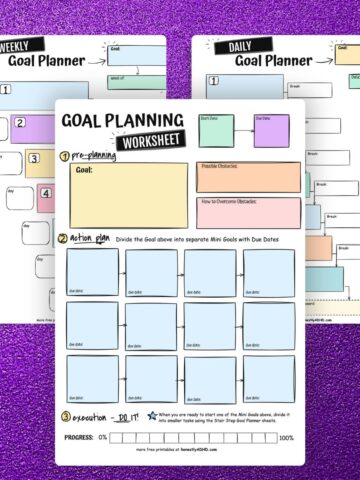
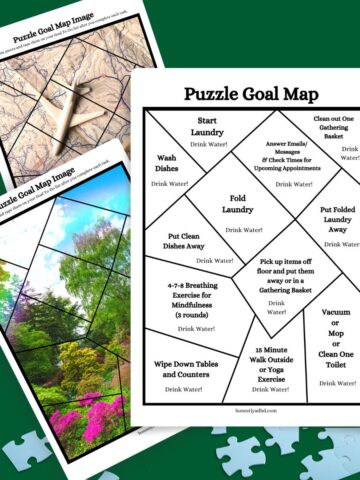
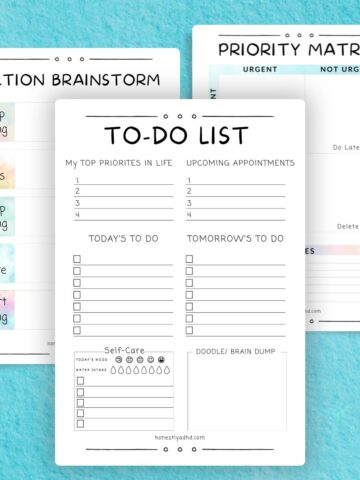

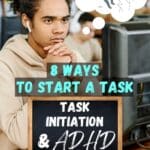
We'd love to hear from you